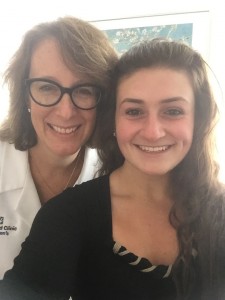When I was young, I remember going to work on special days with my father at the Cleveland Clinic, a tertiary care hospital. We would walk down the long, narrow, white halls and I would watch him as we sat down in giant office chairs overlooking blinding computer screens. The brisk, sterile scent of the hospital and its busy environment was very unique to me. Ever since then, I’ve always considered getting my very own white coat like my father.
For my senior project in high school, I decided to observe Dr. Shannon Phillips in the pediatric ward of the Cleveland Clinic for four weeks. I was exposed to a variety of inpatients, the intensive care unit, the operating room, and the academic world of medicine. I quickly became accustomed to going on rounds with the residents, meeting new patients, and learning about new diseases as each case was presented to the rest of the medical team. I was certainly learned a lot of new terminology and observed a wide variety of different methods to help people. I was exposed to people who actually had very unique and severe diseases and nearly all of them displayed very obvious symptoms of their disorders. Because of the number and breadth of illnesses present at such a facility, I soon became able to apply my knowledge from previous cases, thereby reinforcing my understanding of the pediatric medical field.
Perhaps the most interesting case I came across involved a teenage girl who was admitted for a tumor located in her brainstem (the part of the brain that connects the brain to the spinal cord and is responsible for basic survival needs such as breathing, level of alertness, regulating heart rate, etc.). In order to determine the type of cells in the mass, it was necessary for the doctors to take a sample of the fluid bathing the brain and spinal cord. The problem in this particular case was that the mass was located in a rather inconvenient spot that cannot be readily sampled directly by surgical means without risking damage to vital functions in the girl’s brain. Alternatively, the doctors could even hurt the child by sampling the fluid because of the critical location of the mass. This case was a real challenge. The girl was eventually released because there was nothing the hospital could immediately do to help her. After consulting the family, they pursued a conservative approach and elected to wait to see how the tumor evolved over time and work from there.
I could not stop thinking about this girl. I became obsessed with looking at MRI scans, the electronic medical charts, and reading about different methods to help her. I really was amazed that there was nothing that anyone could do to get rid of her tumor. I couldn’t help but feel empathy for her and her parents.
This single case really opened my eyes and exposed me to the emotions that doctors encounter and have to manage on a daily basis. When I previously thought about being a doctor, I thought of cells, catheters, and MRI machines, which are physical things that are used to heal or diagnose patients. Patients’ emotions were never really much of a consideration when I thought about becoming a doctor. It was not until I was placed directly into a such a serious situation that I began to understand what the patient was facing and I quickly realized that patients’ feelings and well being are both top priorities for the patients’ management.
Before my senior project, I wasn’t entirely sure whether I really wanted to go to medical school after my undergraduate studies were completed at The Ohio State University. Interestingly, this teenage patient really called my attention to the personal and emotional aspects of becoming a doctor which made the profession seem like less of a job and more like an experience that I could easily turn into an enjoyable and rewarding, yet challenging, career. I thoroughly enjoyed every moment of my preliminary four weeks at the hospital and I realized just how excited I was to get started everyday. I began to recognize that I continued to formulate questions about the cases I saw, even after I returned home each night. My mind was focused solely on the patients and their disorders and I recognized that I just couldn’t get enough of it.
Realistically, that means I have a long road ahead of me if I am to achieve this goal. I also am not naive enough to know that I am still young and I have many experiences ahead of me that will continue to refocus my trajectory in life. The Ohio State University is only the first step along that path.

